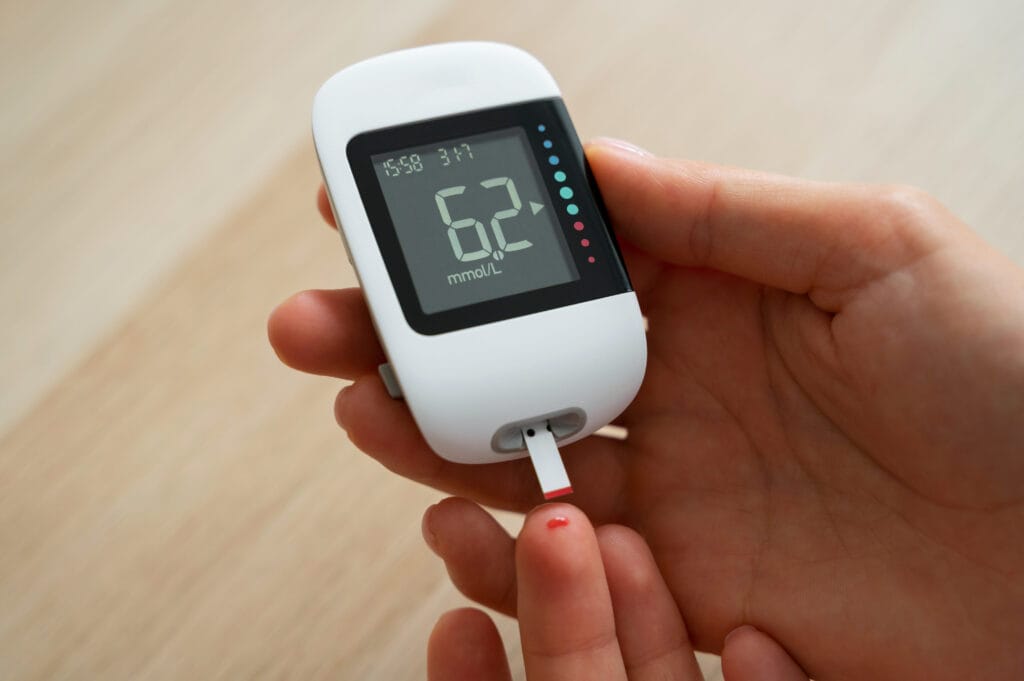
Diabetes is a chronic condition that affects millions worldwide, requiring careful management to maintain a healthy and fulfilling life. Central to this is monitoring blood sugar levels, which empowers individuals to take control of their health. This blog explores diabetes, its types, symptoms, lifestyle considerations, and the critical role of blood sugar monitoring, offering practical insights for those living with or at risk of diabetes.
Understanding Diabetes: What It Is and Its Types
Diabetes is a metabolic disorder where the body either cannot produce enough insulin or cannot use it effectively, leading to elevated blood glucose levels. Insulin, a hormone produced by the pancreas, helps cells absorb glucose from the bloodstream for energy. When this process is disrupted, it can cause serious health complications if not managed properly
Types of Diabetes
Type 1 Diabetes:
- An autoimmune condition where the body attacks insulin-producing cells in the pancreas. It typically develops in childhood or adolescence, though it can occur later. People with type 1 diabetes require lifelong insulin therapy.
Type 2 Diabetes:
- The most common form, where the body becomes resistant to insulin or doesn’t produce enough. It’s often linked to lifestyle factors like obesity and inactivity and is more prevalent in adults, though it’s increasingly seen in younger populations.
Gestational Diabetes:
- Occurs during pregnancy and usually resolves after childbirth, but it increases the risk of developing type 2 diabetes later.
Other Types of Diabetes
- Less common forms, such as monogenic diabetes or diabetes caused by specific genetic conditions or medications, also exist.
Having diabetes means consistently managing blood sugar levels to prevent complications like heart disease, kidney damage, nerve issues, or vision loss. It’s about balancing diet, exercise, medication, and monitoring to maintain stable glucose levels.
Living a Healthy Life with Diabetes
Diabetes is one of the most prevalent chronic diseases in the United States. According to the CDC, approximately 38.4 million Americans (11.6% of the population) had diabetes in 2021, with 1.4 million new cases diagnosed annually. About 90-95% of these cases are type 2 diabetes, underscoring its widespread impact. Alarmingly, 8.7 million Americans have undiagnosed diabetes, highlighting the need for awareness and early detection.
Early Signs of Diabetes
Recognizing early symptoms can lead to timely diagnosis and management. Common signs include:
- Increased thirst and frequent urination
- Unexplained weight loss (especially in type 1)
- Fatigue and irritability
- Blurred vision
- Slow-healing wounds
- Tingling or numbness in hands or feet
If you notice these symptoms, consult a healthcare provider promptly. Early intervention can prevent progression to severe complications.
Lifestyle for Managing Diabetes
Living well with diabetes involves adopting a proactive lifestyle:
Nutrition and Healthy Eating
- Focus on balanced meals with complex carbohydrates, lean proteins, and healthy fats. Limit refined sugars and processed foods. A dietitian can help create a personalized meal plan.
Exercise and Physical Activity
- Regular physical activity, such as 150 minutes of moderate aerobic exercise weekly, improves insulin sensitivity and helps control blood sugar.
Stress Management
- Stress can elevate glucose levels. Practices like meditation, yoga, or deep breathing can help.
The Role of Quality Sleep
- Aim for 7-9 hours of quality sleep, as poor sleep can disrupt glucose regulation.
Regular Blood Sugar Monitoring
- Tracking blood sugar levels provides insights into how food, activity, and medications affect your body, enabling better decision-making.
By integrating these habits, individuals with diabetes can lead vibrant, healthy lives while minimizing risks.
How to Monitor Blood Sugar
Monitoring blood sugar is a cornerstone of diabetes management, providing real-time data to guide treatment decisions. It helps identify patterns, prevent dangerous highs (hyperglycemia) or lows (hypoglycemia), and adjust lifestyle or medication as needed.
What Is a Glucose Monitoring Device?
A glucose monitoring device measures the amount of glucose in your blood, typically using a small blood sample or interstitial fluid. These devices range from portable glucometers to advanced continuous glucose monitors (CGMs), offering options to suit different needs and lifestyles.
Who Should Monitor Blood Sugar?
- Type 1 Diabetes: Frequent monitoring (4+ times daily) is essential, especially for those using insulin.
- Type 2 Diabetes: Monitoring frequency varies. Those on insulin or certain medications (e.g., sulfonylureas) may need regular checks, while others managing with diet or oral medications may monitor less often.
- Gestational Diabetes: Pregnant individuals monitor to protect maternal and fetal health.
- Prediabetes: Occasional monitoring can help track progress and prevent diabetes onset.
Consult your doctor to determine your monitoring needs based on your diabetes type, treatment plan, and health status.
Devices for Blood Sugar Monitoring
Several devices are available, each with unique features:
Glucometers:
Portable devices that measure blood glucose from a finger-prick sample. These include:
- Contour Next One: Known for high accuracy and Bluetooth connectivity to sync with apps.
- Accu-Chek Guide: User-friendly with spill-resistant test strip vials.
- OneTouch Verio Reflect: Offers personalized guidance based on readings.
Continuous Glucose Monitors (CGMs):
Wearable devices that track glucose levels in real-time via a sensor placed under the skin. Top options include:
- Dexcom G7: Compact, with a 30-minute warm-up and 10-day sensor life.
- FreeStyle Libre 3: Affordable, with optional alarms for high/low readings.
- Medtronic Guardian Connect: Integrates with insulin pumps for automated insulin delivery.
Implantable CGMs:
Devices like the Eversense E3 are inserted under the skin by a healthcare provider and last up to 180 days, ideal for those needing long-term monitoring.
When choosing a device, consider accuracy, ease of use, cost (some are subsidized by insurance or programs like the NDSS in Australia), and compatibility with smartphones or insulin pumps.
When to Start Monitoring
Start monitoring as soon as you’re diagnosed with diabetes or if you’re at risk (e.g., prediabetes or gestational diabetes). Your healthcare provider will recommend a schedule, which may include checks before and after meals, before exercise, or during illness.
Types of Blood Sugar Tests
Various tests assess blood glucose levels, each serving a specific purpose:
- Laboratory Tests:
- Fasting Plasma Glucose (FPG): Measures blood sugar after an 8-12 hour fast. Normal: <99 mg/dL; Prediabetes: 100-125 mg/dL; Diabetes: ≥126 mg/dL.
- Oral Glucose Tolerance Test (OGTT): Assesses glucose response after consuming a sugary drink. Used for diagnosing gestational diabetes or confirming diabetes.
- Hemoglobin A1c (HbA1c): Reflects average blood sugar over 2-3 months. Normal: <5.7%; Prediabetes: 5.7-6.4%; Diabetes: ≥6.5%.
- Home Tests (Glucometer): Provide instant readings using a finger-prick sample. Ideal for daily management.
- Continuous Glucose Monitors (CGMs): Track glucose levels every few minutes, offering real-time trends and alerts. Some require occasional finger-prick calibration.
- Implantable CGMs: Long-term sensors inserted by a doctor, reducing the need for frequent replacements.
Each test complements the others, with lab tests confirming diagnoses and home/CGM devices supporting daily management.
Blood Sugar Readings: What They Mean
Understanding glucose readings is key to effective diabetes management. Below is a general guide for non-pregnant adults, based on American Diabetes Association recommendations:
| Time of Check | Target Range (mg/dL) | What It Means |
| Before meals (preprandial) | 80–130 | Within target: Good control. Outside range: May need diet, exercise, or medication adjustments. |
| 1-2 hours after meals (postprandial) | <180 | High readings may indicate overeating or inadequate insulin/medication. |
| Fasting (morning, no food) | 70–99 | Low readings (<70 mg/dL) suggest hypoglycemia; high readings (>126 mg/dL) may indicate diabetes. |
| A1c (%) | <7% | Reflects long-term control. Higher values indicate poor management over time. |
Note: Target ranges vary by individual. Consult your doctor for personalized goals.
Factors Affecting Blood Sugar Results and Best Practices
What Affects Blood Sugar?
- Diet: High-carb meals or sugary drinks can spike glucose levels.
- Exercise: Physical activity typically lowers blood sugar, but intense exercise may cause temporary spikes.
- Medications: Insulin, sulfonylureas, or other drugs directly impact glucose levels.
- Stress and Illness: Both can elevate blood sugar due to hormonal changes.
- Sleep: Poor sleep disrupts glucose regulation.
- Alcohol: Can cause unpredictable fluctuations, especially if consumed without food.
Ideal Times for Monitoring
- Before and after meals: To assess food impact.
- Before and after exercise: To ensure safe activity levels.
- During illness or stress: To catch unexpected changes.
- At bedtime or overnight: To prevent nighttime hypoglycemia.
Keeping Records
Recording readings helps identify patterns and inform treatment:
- Paper Log: Write down date, time, reading, and notes (e.g., food, activity).
- Apps: Many glucometers and CGMs sync with apps like Contour Diabetes or Dexcom Clarity for easy tracking.
- Share with Your Doctor: Bring logs or devices to appointments for analysis.
When to See a Doctor
Seek medical advice if:
- Blood sugar is consistently outside your target range (>180 mg/dL or <70 mg/dL).
- You experience symptoms of hypoglycemia (shakiness, sweating, confusion) or hyperglycemia (thirst, fatigue, blurred vision).
- You notice recurring infections, slow-healing wounds, or numbness.
- You’re pregnant or planning pregnancy, as glucose control is critical.
- You’re starting a new medication or experiencing lifestyle changes.
Immediate care is needed for severe symptoms like seizures, unconsciousness, or persistent high/low readings.
Blood Sugar Tests: Frequently Asked Questions
Q: How often should I test my blood sugar?
A: It depends on your diabetes type and treatment. Type 1 patients may test 4-10 times daily, while type 2 patients may test less frequently if not on insulin. Consult your doctor for a tailored schedule.
Q: Are CGMs more accurate than glucometers?
A: CGMs measure interstitial fluid, which lags behind blood glucose by 5-15 minutes, so they’re slightly less precise but offer continuous data. Glucometers are highly accurate for single-point readings.
Q: Can I reuse lancets or test strips?
A: No, reusing lancets or strips can lead to infections or inaccurate results. Always use fresh supplies.
Q: Do I need a prescription for a CGM?
A: Most CGMs require a prescription, but some, like the FreeStyle Libre 3, are available over-the-counter in certain regions. Check with your provider or pharmacy.
Q: What should I do if my meter gives an error?
A: Check for expired strips, low battery, or improper technique. Contact the manufacturer’s helpline if issues persist.
Questions to Ask Your Doctor
To make the most of your appointments, consider asking:
- What’s my target blood sugar range, and why?
- How often should I monitor my blood sugar?
- Is a CGM or glucometer better for my needs?
- How do my diet, exercise, or medications affect my readings?
- What should I do if I experience high or low blood sugar?
- Are there subsidized programs for testing supplies?
- How often should I get an A1c test?
A Word from Dr. Zara
With my years of experience as a Medical Doctor, I’ve seen firsthand how important it is for patients to take charge of their diabetes through diligent blood sugar monitoring. It’s not just about numbers, it’s about understanding your body and making informed choices. Whether you’re newly diagnosed or managing diabetes long-term, stay curious, keep records, and lean on your healthcare team. If you have questions or need guidance, reach out to me at drzaramulla@gmail.com. Together, we can navigate this journey toward better health.
